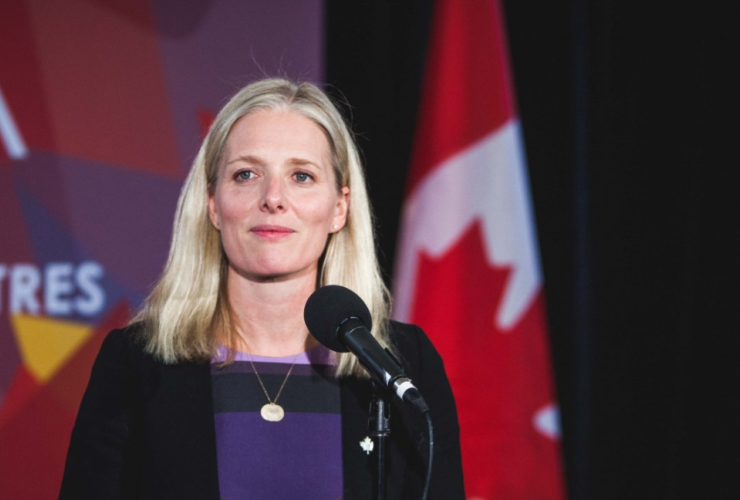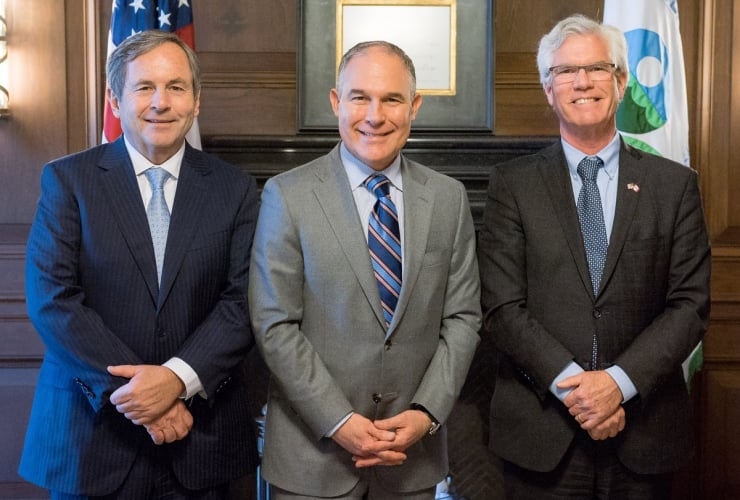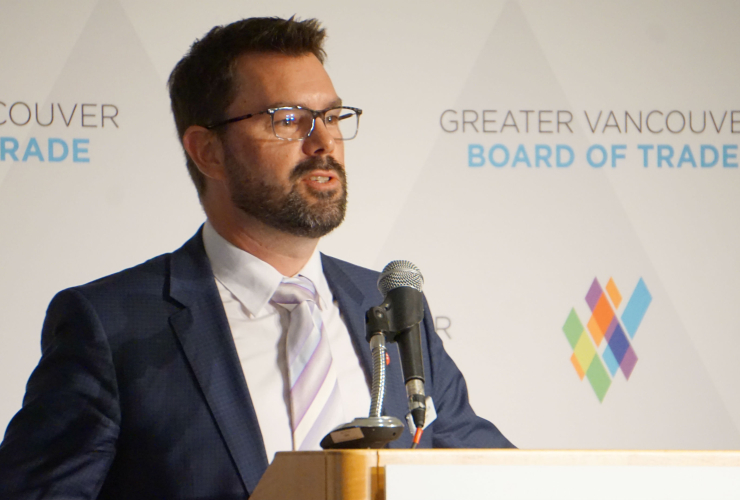There are two perspectives on whether Canada’s fossil fuel industry can adapt to better limit methane gas, a harmful form of air pollution, without a costly and burdensome overhaul of its equipment.
Canada's main oil industry lobby group says that new regulations to limit this heat-trapping pollution would be a “significant burden” with a potential impact on hundreds of thousands of operations nationwide.
That perspective has won the day with the federal Liberal government, at least for now. After the Canadian Association of Petroleum Producers (CAPP) lobbied to delay new regulations “past 2020,” the government did just that, pushing the start date from 2018 to 2020.
"There is a regulatory process. We need to listen to industry," said Environment Minister Catherine McKenna, according to CBC News. "Our goal is to take serious action on climate change to reduce emissions. But we need to be doing it in a smart way where we make sure that we are understanding the perspective of industry and understanding the science."
CAPP says it’s committed to the government’s objective of reducing methane emissions from its equipment 40-45 per cent by 2025, and just needed time to prepare. McKenna's office appeared to agree when it justified the delay by saying it would give industry “more time to make changes to operations.”
The industry group also said implementation costs will be in the “billions” of dollars, although the group told National Observer it can’t specify a dollar amount, or even a cost range, because costs would fluctuate highly from firm to firm. In any case, the government also appeared to agree costs are a factor, saying the delay would give industry time to “budget the capital needed."
But one company at the heart of the industry is offering another perspective.
Audrey Mascarenhas, chief executive officer of Calgary-based Questor Technology Inc., said in an interview that her company has already deployed technology to eliminate methane gas at the source, by incinerating it in closed containers.
She said it’s a “myth” that converting oil and gas equipment to capture methane gas before it escapes into the atmosphere would cost the industry billions of dollars and will take it more time to prepare for. Questor is already deploying its commercial technology now, she said, partnering with many clients around the world, at a far lower cost.
“In some ways, industry does want the narrative to be, ‘there is no technology,’” said Mascarenhas.

Where methane gas comes from
Her comments come as Canada tries to get a handle on the growth of methane emissions from the oil and gas industry, which is responsible for 42 per cent of Canada’s methane emissions. Most of the rest comes from agriculture at 28 per cent and landfills at 22 per cent.
Methane, a colourless, odourless, flammable gas, is one of the world's major greenhouse gases, meaning it traps heat in the atmosphere, contributing to dangerous climate change. Scientists say reducing methane gas emissions is one of the most effective ways of lowering Canada’s climate pollution, as it warms the planet over 80 times more than carbon dioxide in the first few decades after it’s put into the air.
The industry is largely responsible for the nine-per-cent growth of Canada’s methane gas emissions since 1990. While emissions are up from all sources, a federal inventory report said the 8.9-megatonne jump is “largely due to the development of petroleum resources.” Gas that escapes from the fossil fuel industry rose 21.2 per cent between 1990 and 2015, the inventory report said.
Methane represented one seventh of all greenhouse gases created by Canada in 2015. The reason so much is from oil and gas, is because it’s produced by many small pieces of equipment scattered all over Canada’s landscape, said David Layzell, director of the Canadian energy systems analysis research initiative at the University of Calgary.
Some oil or gas wells naturally leak methane as they’re being exploited, while others are pieces of equipment used to contain or transport fossil fuels. Pumps on gas pipelines also release a bit of methane, he said.
Some pressurized equipment is specifically designed to release methane into the atmosphere in order to properly function, said Dale Marshall, national program manager at Environmental Defence. “They are designed to, what they call, ‘bleed’ methane; they keep the conditions of the system at a steady state by venting,” he said.
Methane is also released by accident when oil and gas equipment leaks—through an improperly-attached seal, for example—or malfunctions, like a vent that’s supposed to close but stays stuck open. These kinds of accidents are relatively frequent, according to Marshall. Environmental Defence released a report April 26 that said methane emissions at oil and gas facilities in Alberta were "60 per cent higher than estimates used to compile Canada’s greenhouse gas inventory."
"On average, there is almost one piece of equipment leaking or venting methane at each well, [but] industry is not currently required to look for methane leaks to see if they have a problem," the report said.

Flaring, venting...or gas incineration?
Companies can capture the gas from each of these sources, process it and put it into a pipeline, said Layzell. But because gas is cheap, it’s often not worth the money for companies to set up infrastructure to do this, he said.
Instead, companies simply burn it off, a process called flaring, or release it into the air, known as venting, as a cheap and simple way of getting rid of it. This process is so common that flaring rose 10 per cent from 1990 to 2015, the inventory report said, while venting rose 33 per cent.
But this puts increasingly large amounts of methane into the atmosphere, threatening the climate. So if companies aren’t going to spend the money capturing the gas themselves, Mascarenhas believes she has another solution.
She said her company attaches its equipment to oil and gas devices, captures the methane emissions, then burns the gas at what she says is 99.99 per cent efficiency, producing carbon dioxide and water as byproducts.
Carbon dioxide is also a greenhouse gas, but because methane is so concentrated, she says that converting it to carbon dioxide downgrades its polluting potency. She said incinerating a tonne of methane this way reduces emissions nine fold, and that she can reduce greenhouse gas emissions this way by 60 megatonnes “at a cost of less than $1.70 a tonne."
The industry group, CAPP, isn’t yet convinced. It says it needs to look at the technology more before coming to a conclusion.
“Analysis is required on deployment of commercially-available technology and whether it is more cost-efficient for a new build than it is for the retrofit of existing facilities,” wrote CAPP spokeswoman Chelsie Klassen, in an emailed response to questions.
Oil and gas companies need to collect more data about the types of devices they’re using before figuring out if retrofits make sense, she said. “Industry has a significant inventory of facilities and over 200,000 operations across the country could potentially be impacted,” she wrote.
Klassen stressed that costs would include not just capital investments of new equipment or retrofitting purchases and installations, but also ongoing operating costs related to leak detection and repair. “The costs fluctuate based on staffing, frequency to check sites and repair surveys,” she added.
The implication: This could take a while, and it won’t be cheap.

'Missing one of the easiest ways to have an impact'
Mascarenhas isn’t buying it.
“Take a look at my client list,” said Mascarenhas. “Part of my revenue does come from Canada...we’ve been around for a long time. We build great equipment, we know it works well. We’re best practices for some big companies.”
Questor boasts clients that include some of the biggest names in the industry: Shell, ExxonMobil, ConocoPhillips, Suncor, TransCanada, EnCana, Canadian Natural, Enbridge, Kinder Morgan. Many of its clients are, in fact, members of CAPP.
The publicly-traded firm, which says it has clients in Canada, “the U.S., the Caribbean, Western Europe, Russia, Thailand, Indonesia and China” reported in its 2017 first-quarter results that it had boosted revenue 36 per cent from the same period in 2016.
It attributed the success to the introduction of rental units associated with its gas incineration technology, allowing companies to buy a certain amount of capacity and then rent more depending on need. It expects to grow its rental fleet 36 per cent over the year.
Mascarenhas also points to the company’s efforts in Colorado, the state that became the first U.S. jurisdiction to directly control methane in 2014. She said she’s working with the state’s third-largest driller there now.
The state, which faced serious smog problems and a fracking boom, passed stringent rules on eliminating methane gas in 2014. After new rules went into place, gas production actually went up, while drillers were only down 0.4 per cent of revenues, according to Bloomberg News.
“In Colorado, what they showed was, by forcing people to be innovative and think out of the box, they actually created a better solution,” said Mascarenhas.
In the company’s year-end results, the firm said it’s looking to “expand its presence in Colorado” and is also looking at Texas, which it estimates will have “as much as ten times the activity in Colorado.”
For Mascarenhas, it’s all evidence that Canadians “haven’t created an environment in Canada for technology companies to thrive and grow," because methane regulations forcing change aren't in place.
Companies like hers are “all growing outside of our own backyard,” she said. “We’re missing one of the easiest ways to have an impact on emissions, that makes business sense, that would move the ball forward and get us a fair ways to our target.”
Being released from oil and
Being released from oil and gas wells sites and facilities during operations-drilling, flaring, venting, fugitives, transmission losses-are raw formation gases, not just specifically methane. Formation gases contain a complex mix of hydrocarbons; ethane, pentane, butane, propane, hexane, etc, VOC's including carcinogenic benzene, nitrogen, carbon dioxide, heavy metals and potentially NORM's and H2S. To refer to these emissions as simply methane is scientifically incorrect and misleading, as methane may account for only 60% of the composition of the gases, depending on location and formation specifics.
To state that incineration in field conditions is 99.99% conversion efficient is also unsound. Such rates of efficiency are usually only achieved in lab conditions, with pure fuel, which are generated for manufacturer's specifications on units. Field conditions of incineration performance vary widely, with parameters that alter conversion rates, such as operator error, mixed fuels (formation gases mixed with fracture fluid flowback) inconsistent formation pressures, wind speeds, temperature controls (temp must be maintained over 600 degrees Celsius) and other environmental factors. Incineration efficiencies may be as low as 60% in field applications.
Formation gas management is absolutely necessary, but conservation is preferable to combustion. However, the story remains the same, industry operators and lobbyists persist in avarice and enduring failure to protect the environment and public health.
Industry could willingly redirect the money being funnelled into worthless and wasteful lobby and synergy groups and apply this substantial funding for formation gas management.
Like all the wonder solutions
Like all the wonder solutions that Big Oil and Tar come up with to convince us we can continue with 'business as usual' and make our Paris targets........this latest brainwave sounds just a bit like fake news. Hahahaha.,. If you read the comment from Diana D, it turns out nothing is as pure as we'd like it to be.
Not even Methane.
Be sure to read the comment
Be sure to read the comment here by Diana Daunheimer. She regularly turns up in comments sections to challenge accepted ways of thinking with technical information no one else seems to have their hands on.
As for the idea that CAPP is resisting the “significant burden” of having to control methane pollution, CAPP really started squawking when Trump made his move. “Energy companies are worried about their ability to compete with their U.S. counterparts now that the Trump administration has scrapped Obama's plans to control methane emissions.” http://www.cbc.ca/news/politics/methane-emissions-regulations-changes-1....
The Liberal government was happy to go along with their friends at CAPP!
Re.Comments 3 years ago (
Re.Comments 3 years ago ( may18, 2017 - 3 yrs. ~ 2017 ) about Methane and CO2 emissions, what is contact info for Diane Daunheimer ?
" conservation is preferable " " persist in avarice " and "failure to protect the environment " She must have more well chosen words to say.
I am a retired Engineer, Etheticist & Technologist






Comments